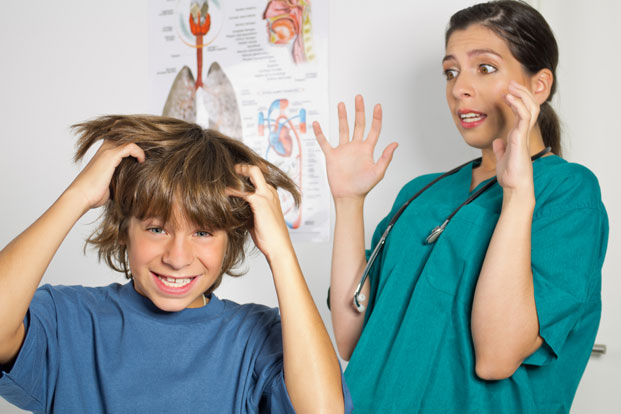Do you know how to treat a lice infestation? Unless you’ve been through the process, chances are that you don’t know whether you need a flamethrower or a pair of tweezers.
It’s almost certain if you have a child in school that you’ll receive a letter at some point in their academic career concerning lice. Usually, a school nurse will detect an outbreak, and the dutiful school administrators will alert the parents to examine their offspring’s heads closely for signs of the creatures.
Lice (the plural of louse) are small, parasitic, wingless bugs that thrive in human hair, where they affix themselves to hair follicles and feast on blood from the scalp. They are contagious, annoying and somewhat hard to get rid of, but they are not particularly dangerous. They do not transmit disease and can’t be shared with pets, although they do cause a lot of itchy scalps, which can become infected if the lice aren’t removed.
Ultimately, with a little attention and medicated shampoo, infected kids will be back on track, minus the lice.
What to Do About Those Tiny Little Nuisances
A lice outbreak will be visible to the naked eye and are usually seen as nits on the hair follicles rather than live lice. They may be tan, yellow or brown and are about the size of tiny watermelon or sesame seeds. Because they are contagious, an outbreak on one person will usually lead to a cluster of three or four infected people. Hence, the letters home to remind parents to check for them.
A medicated shampoo, lotion or cream applied directly to the hair is the usual treatment. This requires patience because the procedure needs to be repeated, and a fine-toothed comb needs to be used to remove any remaining nits. Medicated shampoos are available over-the-counter or with a prescription and usually are good for use on anyone 2 years and older. But as with any medication, read the directions carefully and ask a doctor if you are unsure about any use for a child or other person with any special medical condition.
Obviously, the one surefire method of avoiding lice is to avoid head-to-head contact. Lice can be passed along by trading hats or clothes, putting heads together for selfies, or close contact in the school yard. Once they are present, washing with medicated soap and careful removal of the nits are necessary.
Bugging Out? What Not to Do
Be careful not to use a hairdryer after applying certain scalp treatments. Some contain flammable ingredients, plus a hairdryer may blow away any lice nits, allowing them to come into contact with others. Nits can live outside the body for up to two days.
Use a medicated shampoo and be sure to wash all bedding and clothing that the child has worn or used in the immediate days before a lice notification. This will help kill off any remaining nits. Dry clean things like stuffed animals or anything else that may have come in contact with a child’s scalp or bedding. If dry cleaning isn’t feasible, putting them in airtight bags for three days usually will kill any bugs.
If medicated treatments don’t seem to be working, it may be time to consult a medical professional. In addition to stronger medications available by prescription, a doctor may also recommend some oral medications for particularly tough cases.
One caution: Do not use what are termed “essential oils,” including ylang-ylang oil or tea tree oil. These are touted as lice cures but can lead to allergic reactions. These medications are not Food and Drug Administration approved, and there are no clinical studies to indicate that they have any effect on head lice.
Some people may recommend using gasoline or kerosene on a child’s head to eliminate the lice. The theory goes that these severe poisons will certainly kill off the bugs. Of course, putting a highly flammable and poisonous solution on a child’s head is never a good idea.
Vacuuming the children’s rooms is a good idea, taking care to throw away the vacuum bag or emptying the collection area outside. Make sure to soak any hair products like combs, brushes, barrettes, ties or bands in rubbing alcohol or medicated shampoo. Or simply throw them away and buy new ones.
At one time, doctors recommended that children who were found to have head lice should stay home until cured. That’s no longer the case, and after treatment with a medicated shampoo, children are usually sent back to school with the warning to avoid sharing hats, combs and brushes with their peers.
Keep in mind that head lice isn’t a sign of neglect, poor hygiene or careless, dirty behavior. Any economic level can acquire the bugs, no matter if they bathe every night or not, and long- or short-haired people are equally affected.
Once you feel that you’ve beaten lice, it’s time to keep a watchful eye out for another few weeks. Lice are stubborn and resistant, and even the best-medicated shampoos may miss a spot or create another opportunity for reinfection. It’s a simple task to take a minute out of the day and look at a child’s scalp to see if there are any tell-tale signs of lice. Because the bugs spread in group settings, it can be a battle to make sure they are eradicated. Watchfulness and medicated shampoo are the formulas to keep repeating. If you are patient and follow directions, you’ll eventually beat the bug. Just remember that it’s not the child’s or your fault. It’s just one of those life things that reminds us that we all share the same planet.

Leave a Reply